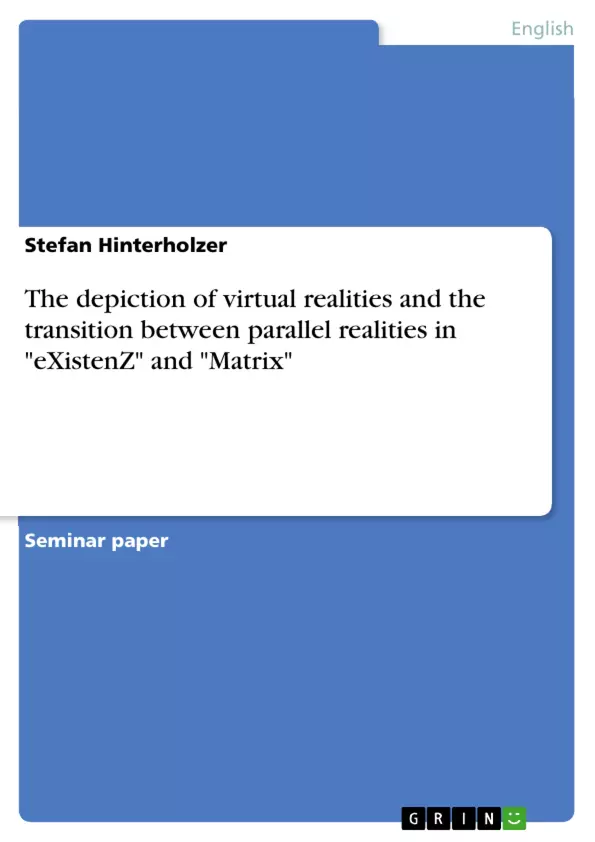The depiction of virtual realities seems to be very popular in modern film production. eXistenZ and Matrix are only two examples of films belonging to the genre of “cyberpunk”. This genre mainly deals with human beings and their bodies and their relationship to technology and their environment. There is a strong focus on the “anxiety over […] the technological creation of alternative realities and consequent loss of a stable perceptual ground for reflection” (Hotchkiss 19).
Cyberpunk started as a subgenre of science fiction dealing with the “altering of the human body through pharmaceuticals and electronics” (Hotchkiss 19). This topic was quite poplar in the sixties and seventies when parts of the society were very suspicious of totalitarian corporate control. Cyberpunk reached its climax in the mid-eighties again dealing with the interfering of body and mind through “protheses, implanted circuitry, cosmetic surgery, genetic alteration, as well as brain- computer interfaces, artificial intelligence, [and] neurochemistry” (Hotchkiss 19).
As mentioned both eXistenZ and Matrix deal with these virtual realities and their impact on human beings, though in different ways. In both films the characters travel to these virtual realities and back, but they have different motives, there is a different philosophy behind these transitions. As a consequence different filming techniques are used. In this paper I am going to analyze how these transitions between parallel realities are depicted and which effects are created through certain techniques. Furthermore other aspects concerning these transitions between parallel realities, such as the requirements to make such a transition possible, will be taken into consideration.
My argumentation will be supported by certain scenes from the two films that can be found on the CD-ROM that is attached to this paper. In the text the reference to the clips is made like this: <Clip1.mpg>. These scenes and also the quotations of characters are taken from the DVDs of eXistenZ and Matrix that are listed in the bibliography. [DVD available: csaf3248@uibk.ac.at]
Table of Contents
- Introduction
- Reality and virtual realities
- Hostile groups
- Escape from (virtual) reality
- Free will
- Absoluteness of the transition
- Existence of an absolute reality
- Levels of reality and narration
- Matrix
- eXistenZ
- Transition
- eXistenZ
- Matrix
- Artificiality
- Lighting
- Artificial objects, actions and surroundings
- The additional orifice
- Existence or eXistenZ?
Objectives and Key Themes
This paper examines the depiction of virtual realities and the transition between parallel realities in the films "eXistenZ" and "The Matrix." It explores the unique approaches taken by each film in presenting these concepts, analyzing how different filming techniques contribute to the overall experience. The paper also investigates the philosophical implications of virtual reality and the nature of human existence within such environments.
- The portrayal of virtual realities and their impact on human perception
- The transition between parallel realities and its philosophical implications
- The use of filming techniques to create specific effects and perspectives
- The role of technology in shaping human identity and experience
- The concepts of free will and reality in virtual environments
Chapter Summaries
- Introduction: This chapter introduces the topic of virtual reality in film, particularly within the "cyberpunk" genre, and highlights the anxieties surrounding the creation of alternative realities. It focuses on the films "eXistenZ" and "The Matrix" as examples of this genre.
- Reality and virtual realities: This chapter explores the similarities and differences between the virtual realities presented in "eXistenZ" and "The Matrix." It examines the concept of hostile groups opposing these virtual realities, the desire to escape from them, and the implications for human free will within these environments.
- Levels of reality and narration: This chapter analyzes the specific narratives and storytelling techniques employed in "The Matrix" and "eXistenZ" to present different levels of reality.
- Transition: This chapter focuses on the visual depiction of the transition between parallel realities in both films, examining how these transitions are achieved and the effects created through specific techniques.
- Artificiality: This chapter explores the use of artificial elements, lighting, and surroundings in both films to enhance the sense of artificiality and distinction between real and virtual realities.
- The additional orifice: This chapter examines the concept of the "bio-port" in "eXistenZ," highlighting its role in connecting players to the virtual world.
- Existence or eXistenZ?: This chapter delves into the philosophical implications of the virtual reality presented in "eXistenZ" and its impact on the nature of human existence.
Keywords
The primary keywords and focus topics of this paper include virtual reality, cyberpunk cinema, "eXistenZ," "The Matrix," parallel realities, transition techniques, filming techniques, human perception, free will, and the philosophical implications of virtual environments. The paper further explores the concepts of hostile groups, escape from reality, and the role of technology in shaping human identity and experience.
- Citar trabajo
- Stefan Hinterholzer (Autor), 2006, The depiction of virtual realities and the transition between parallel realities in "eXistenZ" and "Matrix", Múnich, GRIN Verlag, https://www.grin.com/document/75415



